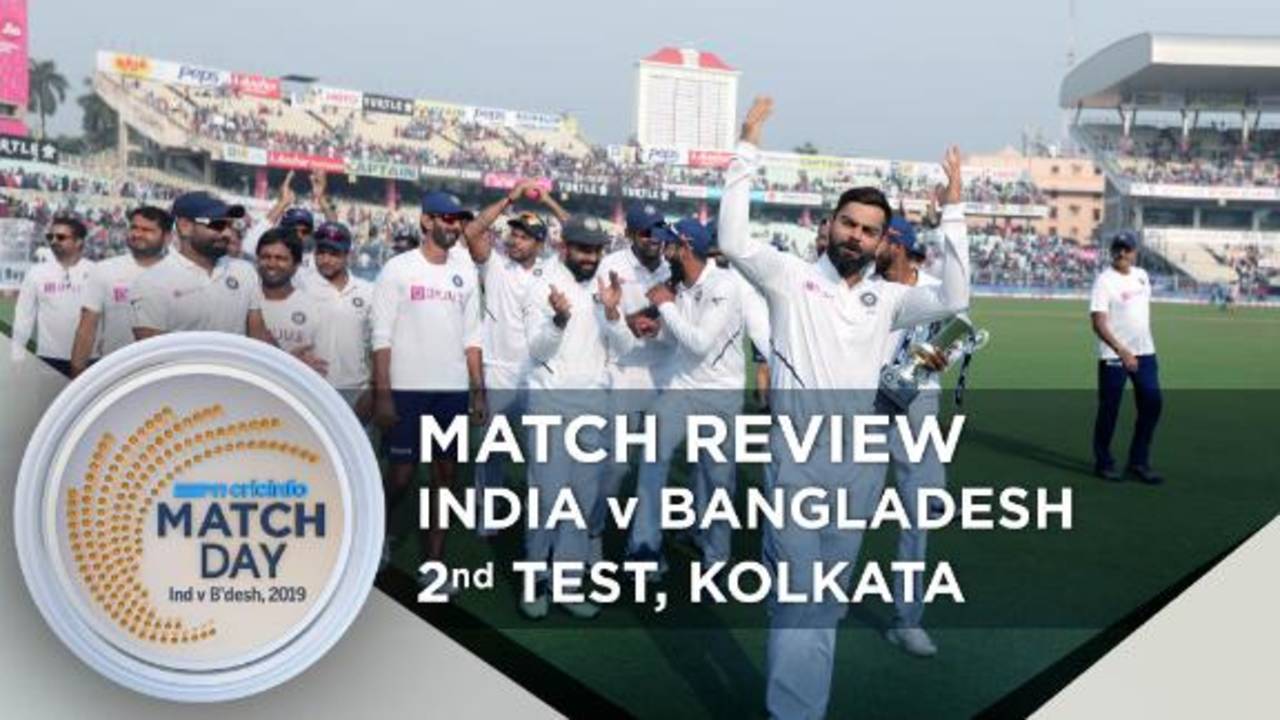The twilight report: Pink ball under spotlight as spinners left in shade
The first day-night Test in India was also the shortest ever played in the country. Here's what we learned from it.
Varun Shetty at Eden Gardens
25-Nov-2019
It became the shortest Test match ever played in India, so we may not yet know everything we need to about the pink ball but here's what we did learn about it.
Movement
The new pink ball did not spring up anything alarmingly different from the regular red ball, but India's fast bowlers had to adjust and be fuller after being rather wayward in the first hour or so. The only exaggerated movement seemed to be coming after the ball went past the batsman but, again, that happens with the red ball as well.
Both teams found conventional swing even with the semi-new ball, but there were no signs of reverse swing throughout the Test. In the two late evening sessions, batting looked a lot easier with the advent of dew. These factors could all be much the same if India continues to play pink-ball cricket in the winter.
Did the ball last?
In the longest innings of the match, India's first innings of 89.3 overs, three balls were used - two new balls and one replacement ball. The first ball went out of shape and was changed in the 59th over when India were scoring at a healthy rate and boundaries were aplenty.

The lights come on at Eden Gardens for India's first ever day-night Test•BCCI
The atmosphere, the attendance
After the match, Virat Kohli said that among the many challenges was a tiny mental adjustment he had to make - that he wasn't stepping into an IPL game.
That's a glowing review for Kolkata, for Eden Gardens, and for the BCCI. The first day, understandably, was filled to the brim right through. Only after the day ended were there any problems with attendance because, let's face it, no one likes opening ceremonies.
Another big plus was that the second day, a Saturday, began with what appeared less than half the number of the first day. But by the end of the day, Eden Gardens was packed again.
Visibility
Possibly the biggest takeaway from the match is that at least four different Bangladesh players were hit on the head through the course of the game. Three of those were regular batsmen, including their best one, Mushfiqur Rahim. Bangladesh had a relatively inexperienced side, but by no means were the batsmen facing decent pace for the first time. India's batsmen rarely had to face anything close to 135kph in this match, and even so weren't subjected to much short bowling by the Bangladesh seamers apart from Mohammed Shami at the end.
The consensus from those who spoke through the game - Russell Domingo, Mominul Haque, Al-Amin Hossain - was that the visibility was okay. Cheteshwar Pujara, however, reckoned visibility might have played a part.
There was also the issue of how much the spectators could actually see - from the upper stands above where the Eden Gardens bell is located, the pink ball was difficult to see every time it raced across the outfield under artificial lights. There's a good chance cricket might move to whiter lights in this format at some point. What works for the white ball might not be an automatic pick for pink.

Mahmudullah is roughed up by a rip roaring bouncer•BCCI
Was the ball moving about quicker?
Virat Kohli suggested before the match that the extra lacquer on the ball might be making it travel quicker through the air. While the ball is made to the same prescribed weight as a red ball, Kohli got the feeling it was hitting the hands heavier and said it felt like catching a hockey ball.
Two clear catching chances went down during the match - one at slip against R Ashwin, and one at fine leg. One of the best catches of the match, Taijul's to dismiss Kohli, came after he'd misjudged the ball and had to adjust quickly to dive backwards.
This was probably also a factor in so many batsmen being hit in the head.

Ishant Sharma, Mohammed Shami, and Umesh Yadav are all smiles•BCCI
The T-word
In a throwback to 2008, twilight was all the rage again in the build up to this match. But it didn't turn out to be quite the enigma.
For one, Kolkata has a quick transition from light to dark, and the slim period in between is pretty early on in the day. There isn't a significant twilight phase to analyse because of this, but there certainly was action when it got dark. That was when both teams had most problems when batting. Particularly on the second day, when nine wickets fell in the middle session with both teams facing the new ball. Kohli and Sachin Tendulkar were both of the view that the typical morning survival tone of Test batting will come in the second session in this format. Could teams try using openers in the middle order at some point in the future?
Spin
Was on offer. The dew and a rampant fast-bowling attack made the spinners an afterthought for India, but Taijul found considerable turn for Bangladesh. In a small spell, Ashwin too found turn. Pujara said this was because the pink SG ball offered more for spinners than the Kookaburra ball.
Varun Shetty is a sub-editor at ESPNcricinfo
